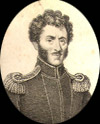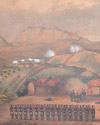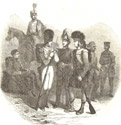19th Century´s militar history in the Basque Country
SIR GEORGE DE LACY EVANS. (1787-1870)
 Born in Moig (Ireland) in 1787, he enlisted as a volunteer in the army in 1806 and his first destination was India. He took part in the Spanish War of Independence, in the Battle of Vitoria, among others, where Wellington's troops defeated Napoleon. After taking part in the Battle of Toulouse, he joined General Ross' High Command and played a major role in the conquest of Washington and Baltimore by the British troops in 1814. He returned to Europe to take part in the final Battle of Waterloo, where he had two horses shot from under him by the enemy. He ended this final campaign against Napoleon with the title of Captain.
Born in Moig (Ireland) in 1787, he enlisted as a volunteer in the army in 1806 and his first destination was India. He took part in the Spanish War of Independence, in the Battle of Vitoria, among others, where Wellington's troops defeated Napoleon. After taking part in the Battle of Toulouse, he joined General Ross' High Command and played a major role in the conquest of Washington and Baltimore by the British troops in 1814. He returned to Europe to take part in the final Battle of Waterloo, where he had two horses shot from under him by the enemy. He ended this final campaign against Napoleon with the title of Captain.
Due to his political concerns, he entered Parliament in 1830 and was elected in consecutive elections until he retired from politics in 1865. Unusually for a soldier, he took a Liberal stance and yet this did not hinder him in his career.
 In 1835, he agreed to command the British Auxiliary Legion sent to Spain to defend the interests of Isabel II in the First Carlist War. This army corps was made up of volunteers who had to be trained as soldiers due to the poor military experience of many. Evans led the Legion in the main actions of this war in which it participated: the defence of San Sebastián from the Legion's arrival in July 1835; the Battle of Arlabán in January 1836; the defeat of Oriamendi in March 1837, and the control of the stretch of coastline from Pasajes to Irun in May of the same year.
In 1835, he agreed to command the British Auxiliary Legion sent to Spain to defend the interests of Isabel II in the First Carlist War. This army corps was made up of volunteers who had to be trained as soldiers due to the poor military experience of many. Evans led the Legion in the main actions of this war in which it participated: the defence of San Sebastián from the Legion's arrival in July 1835; the Battle of Arlabán in January 1836; the defeat of Oriamendi in March 1837, and the control of the stretch of coastline from Pasajes to Irun in May of the same year.
During this period, the British built a fort over Pasajes of San Juan, to which they named Lord John Hey in honour to the person in charge of the British Navy in the Cantabrian.
Shortly afterwards, when he reached two years' service, Evans returned to Britain despite the attempts of the Spanish authorities to keep him at the front of the Legion. On his arrival in London, he was made a Sir and his military rank was raised in view of his service during the campaign.
 After fighting in the First Carlist War, he returned to politics but did not leave the army. In 1854, he was appointed Commander of the 2nd Division of the Eastern Army in the Crimean War. He played an essential role in the victory of the Battle of Alma, where he was injured. He was congratulated by the House of Commons for his brilliant performance in this war on his return in February 1855.
After fighting in the First Carlist War, he returned to politics but did not leave the army. In 1854, he was appointed Commander of the 2nd Division of the Eastern Army in the Crimean War. He played an essential role in the victory of the Battle of Alma, where he was injured. He was congratulated by the House of Commons for his brilliant performance in this war on his return in February 1855.
In 1861, he was made a general. He died in London on the 9th of January, 1870.

